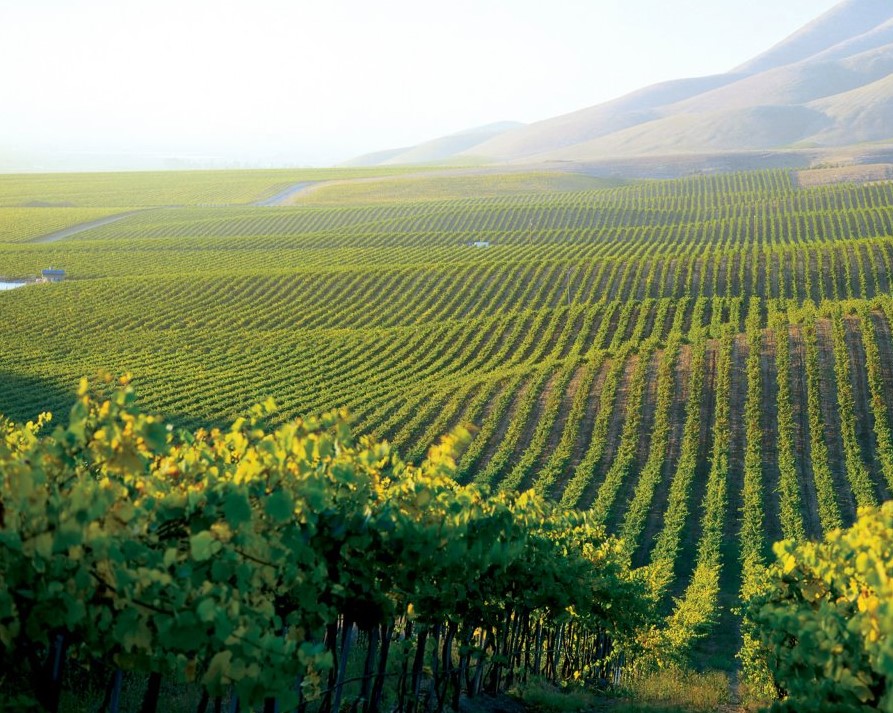
Santa Barbara County’s famous winemaking region just received its seventh unique AVA (American Viticultural Area) wine region.
Formally recognized as “Alisos Canyon” this new wine appellation located near the historic stagecoach town of Los Alamos, is admired for its high-quality fruit idyllic for Rhone-style varietals.
Nestled between the Santa Maria and Santa Ynez Valleys, this region is ideal to grow Grenache, Syrah, Mourvèdre, Viognier and Roussanne and other Rhone Varietals.



Alisos Canyon AVA Unique Characteristics
The new wine appellation encompasses 5,774 acres, with about 240 acres of wine grapes currently planted on nine vineyards.
The petition for the new AVA highlighted the following as some of the unique characteristics of the region:
- Sandstone and shale-based soils, including a good deal of viticulturally significant Paso Robles formation soils (gravel [shale pebbles] combined with sand, clay, and limestone)
- A consistent and unique climate (as compared to the areas that surround it); specifically, warmer (and with less fog) than the areas to the west and north, but cooler and drier than those to the east.
- Cooling maritime influence funneled into the region along the San Antonio Creek Drainage basin
- Elevations ranging from 673 feet/205 meters to 1412 feet/430 meters
Santa Barbara County 7 AVAs
Wes Hagen with J Wilkes Wines, was one of the several who successfully petitioned to secure the Alisos Canyon AVA designation. Mr. Hagen was also responsible for the AVA approvals for Santa Rita Hills (2000), Happy Canyon (2009) and Ballard Canyon (2013), all within Santa Barbara County.
The other three Santa Barbara County AVA wine regions include Santa Maria Valley (1981), Santa Ynez Valley (2013) and the Los Olivos District (2016).
Alisos Canyon Varietals, Climate and Soils
The Alisos Canyon area is slightly warmer than the Sta. Rita Hills, famous for it’s Pinot Noir and Chardonnay, and a bit cooler than Ballard Canyon also noted for Rhône grapes. The area is cooled by ocean breezes coming through the San Antonio River Valley but is still warmer and has less fog than the AVAs to the north and south.
The unique micro-climate and weathered sandstone and shale soils produce wines elegant in flavor, with considerable longevity and vivid aromatics.
In addition to Rhone varietals, vineyards in Alisos Canyon grow biodynamic Tempranillo, Albarino, Gamay, Cabernet Franc, Barbera, Sangiovese and Nebbiolo.



What Is an AVA (American Viticultural Area)
An (AVA) or American Viticultural Area, is a designated appellation for vineyards in the United States distinguishable by geographic, geologic, and climatic features and approved by U.S. Alcohol and Tobacco Tax and Trade Bureau (TTB). An AVA is distinguished by its unique geology, soil structure, and climate pattern.
Noted local producers including Thompson Vineyard, Watch Hill Vineyard, Alisos Vineyard, Black Oak Vineyard, and Martian Ranch can now label their wines with the newly created Alisos Canyon AVA.
Santa Barbara County Wineries and Grape Varietals
Santa Barbara County is one of the most diverse grape-growing regions in the world. There are over 275 wineries in the county of Santa Barbara and over 70 different grape varieties planted, with the most popular being Chardonnay, Grenache Blanc, Cabernet Franc, Pinot Noir, and Syrah.
The Alisos Canyon AVA Petition Excerpt
Distinguishing Features of the Alisos Canyon AVA
“The distinguishing features of the proposed Alisos Canyon AVA are its climate and soils.
Climate
“The proposed Alisos Canyon AVA is located along with the drainage system of San Antonio Creek, which flows into the Pacific Ocean. Cool marine air travels inland via the drainage system and affects temperatures. As the air travels up the San Antonio Creek and its drainage system, it becomes warmer. The proposed AVA is approximately 25 miles from the ocean and situated in a transitional region, between the cooler coastal regions and the warmer inland areas. According to the petition, the proposed AVA’s location is a “Goldilocks Rhone Zone,” meaning that temperatures are neither too hot nor too cold for growing Rhone wine varietals such as Syrah, which is the most common varietal grown in the proposed AVA.”
To the northwest and southwest of the proposed AVA, the GDD accumulations are lower due to the proximity of the Pacific Ocean and the greater cooling influence of the marine air. To the immediate north of the proposed AVA in Sisquoc, GDD accumulations are higher than within the proposed AVA because ridges and hills trap warm air and block the cool marine air from entering that region. East and southeast of the proposed AVA, GDD accumulations become significantly higher as one moves beyond the extent of the marine influence. South of the proposed AVA, within the existing Ballard Canyon AVA (27 CFR 9.230), the GDD accumulations are also higher. According to the petition, the east-west valleys that bring cool marine air inland end prior to reaching the Ballard Canyon AVA, resulting in warmer temperatures than are found in the proposed Alisos Canyon AVA.
Soils
According to the petition, the soils of the proposed Alisos Canyon AVA are primarily derived from sandstone and shale. The most common soils within the proposed AVA are the Paso Robles Formation and Careaga Sandstone, which comprise 63 percent and 13 percent of the total soils, respectively. The petition describes the Paso Robles Formation as conglomerate or gravel composed mostly of siliceous shale pebbles in sandy to somewhat clayey matrix. The petition states that the high calcium content from the shale pebbles increases the thickness of the skins of red varietal wine grapes, which in turn increases the color and tannin levels in the resulting wine. The clay content aids in the uptake of nutrients to the vines.
Careaga sandstone is described as soft, fine-grained sandstone or sand, along with small marine shell fragments or pebbles. The petition states that the high sand content of the soil provides excellent drainage in vineyards, thus reducing the risks from certain pests such as nematodes and phylloxera. The low level of clay in the Careaga sandstone soils reduces the uptake of nutrients and reduces the vigor of the vines. As a result, the vines produce grapes that are smaller and have a higher skin-to-juice ratio than grapes of the same varietal grown in different soil.
The petition states that the soils to the north of the proposed Alisos Canyon AVA, in the Santa Maria Valley, have sandier topsoils than are found within the proposed AVA. South of the proposed AVA, the soils are characterized by Metz fine sandy loam. To the east of the proposed AVA, the soils are primarily derived from serpentine and chert, rather than sandstone and shale. To the west of the proposed AVA, the soils are described as deep, sandy soils of the Shedd, Chamise, and Point Sal Formation series.
Summary of Distinguishing Features
In summary, the climate and soils of the proposed Alisos Canyon AVA distinguish it from the surrounding regions. The proposed AVA has GDD accumulations that are higher than the marine-influenced regions to the northwest and southwest and are lower than the regions to the north, south, east, and southeast. The soils of the proposed AVA are derived primarily from sandstone and shale, and the most common soils are the Paso Robles Formation and Careaga sandstone. By contrast, the soils to the north of the proposed AVA contain more sand in the topsoil. The soils to the west of the proposed AVA are deeper and sandier than those of the proposed AVA, while the soils to the south of the proposed AVA are very fine sandy loams of the Mertz series. The soils to the east of the proposed AVA are derived from geologic parent materials that are not found within the proposed AVA.”

